 If you have the misfortune of finding yourself on Washington’s Capital Beltway, alias Hell’s Freeway, where snails can get to your destination well ahead of you, there is an exit that will take you westward to a land virtually unspoiled by urban civilization, noise and pollution. It lies at the foothills of the Blue Ridge Mountains. Taking the Interstate 66 exit you will glide past the clutter and cacophony of Washington’s overbuilt Virginia suburbs and enter a region loaded with history, natural beauty and people in no hurry at all.
If you have the misfortune of finding yourself on Washington’s Capital Beltway, alias Hell’s Freeway, where snails can get to your destination well ahead of you, there is an exit that will take you westward to a land virtually unspoiled by urban civilization, noise and pollution. It lies at the foothills of the Blue Ridge Mountains. Taking the Interstate 66 exit you will glide past the clutter and cacophony of Washington’s overbuilt Virginia suburbs and enter a region loaded with history, natural beauty and people in no hurry at all.
In this particular rural neighborhood one can visualize a long line of soldiers in grey uniforms, accompanied by assorted cannons, caissons, horses and random camp followers making their way to the nearby Shenandoah Valley where their leader, a certain General Stonewall Jackson, will begin a brilliant campaign that soon will lead everyone to believe that ultimate victory by the South in the Civil War is a foregone conclusion. This is Civil War country and a place worth visiting.
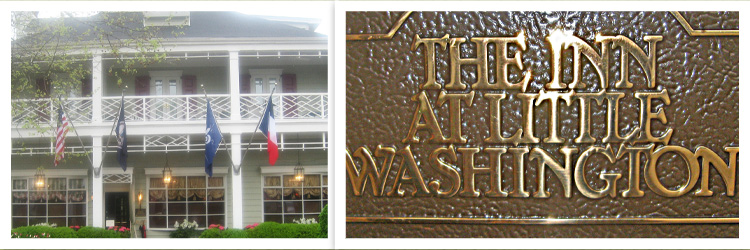
On one recent excursion to that area, requiring a passage around the character-building DC Beltway my GPS guided us off onto I-66, heading west toward the Blue Ridge foothills, toward the bucolic Virginia farmland landscapes and ultimately to the intended destination for this trip, a town called Washington in Rappahannock County and to a famous bed & breakfast called the Inn at Little Washington.
Little indeed. The town is basically one intersection – no light – with shops and houses stretching for about two blocks in all directions. The connection to George Washington is a bit murky but he supposedly passed through the neighborhood at one time or another for a pit stop before he took on the British. The Inn itself is as little as the town but it is home to one of America’s greatest kitchen magicians – the Inn’s chef-owner Patrick O’Connell.
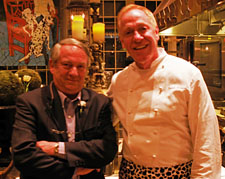 Chef O’Connell is a person who can probably duplicate any classical dish from any ethnic or regional cuisine in the world with his eyes closed. However his masterpieces are not strictly classic. They are original creations in every sense yet they have features easily and gratefully recognizable by classical one-track-minded amateur cooks like me.
Chef O’Connell is a person who can probably duplicate any classical dish from any ethnic or regional cuisine in the world with his eyes closed. However his masterpieces are not strictly classic. They are original creations in every sense yet they have features easily and gratefully recognizable by classical one-track-minded amateur cooks like me.
For proof I refer to his superb cookbook, the somewhat curiously titled “Refined American Cuisine” (Bullfinch Press, New York, 2004). Refined indeed, as if there is a version of traditional American cooking that is not refined?? Well, if not then Chef O’Connell accomplishes the refinement with subtle touches from the classical repertory that give American cuisine an added measure of respect. In the words of the well known Boston-accented Portuguese-American celebrity TV chef, “he kicks it up a notch.”
The perfect example is his version of mac ‘n cheese prepared with Virginia country ham and shaved white truffle, all of which is enclosed in a parmesan crusted basket. It’s an inspired reinvention of an everyday American household dish that echoes classical themes. The obvious classical connection is shaved white truffle – a staple accent in all sorts of dishes from France and Italy mostly, but also found in many other European traditions. The American star ingredient is of course the Virginia country ham, a close cousin of Italian prosciutto. Close but not too close mind you.
Some background on mac n’ cheese that you can and should skip:
Chef O’Connell’s combination of ingredients recall a highly popular dish from Rome and Central Italy called Maccheroni alla Gricia Tartufati. The name “Gricia” comes with a long story as to its origin but in short is associated with a town called Grisciano, just as pasta all’ amatriciana is linked to the nearby town of Amatrice. Other continental relatives of “mac ‘n cheese” are Rome’s famous pasta cacio e pepe, and pasta alla carbonara.
All three varieties have cheese, usually pecorino romano, coarsely ground black pepper , creamy sauce and a cured pork component, whether pancetta, guanciale or prosciutto. Truffles slices are not always a part of the old country versions but many upscale Italian restaurants, Pagnanelli at Castelgandolfo outside Rome for example, finish the dish with a sprinking of shaved black or white truffle.
So, putting all this together, upon returning home from a fairy tale experience at the Inn, I decided I would someday soon attempt Chef O’Connell’s formula for mac ‘n cheese straight from his cookbook (p. 108) and then, in the spirit of friendly competition, maybe at my next house party, include also a serving of my recipe for Maccheroni alla Gricia Tartufati. I then would ask unbiased volunteers to sample each one and render an opinion. Of course as a person who, if nothing else, can tell the difference in a dish between Virginia country ham and pancetta or prosciutto I already have an opinion but I’ll keep it to myself.
Not wanting to leave the wrong impression I can testify that Chef O’Connell’s elevated version of American macaroni and cheese is five-star and could easily bring me back to Little Washington many more times henceforth.
Before presenting his recipe I should note that fresh truffles are tough to latch onto and in any case will put a big hole in your wallet should you find any. Truffle oil on the other hand is readily available in specialty stores like Balducci’s or on line. So in a pinch a drizzle of truffle oil will provide you with a rough idea of what the real thing can do in a dish like this.
Chef O’Connell’s Mac ‘n Cheese
For 4 persons
-
3/4 cup cut pasta of your choice (this quantity strikes me as way too low for 4 pasta addicts so make it 2 cups)
-
1 tbsp. olive oil
-
2 tbsp. butter
-
1/4 tsp. minced garlic (quite a tiny amount seems to me)
-
1/2 tbsp. minced shallot
-
2 cups heavy cream
-
1/2 cup freshly grated aged Gouda (pronounced “Howda” by the Dutch)
-
1/4 cup freshly grated Parmesan (not the stuff in the green can)
-
pinch of freshly grated nutmeg
-
salt & freshly ground black pepper (the Italian versions often call for cracked black peppercorns)
Garnishes:
- Parmesan crisps or wafers formed into a basket or bowl shape (See recipe below)
- two slices Virginia country ham thinly julienned
- 2 tsp. finely chopped chives
- Crispy fried onions (not the canned stuff, see recipe below)
- White truffle slices
The following narrative on preparation is paraphrased from the Chef’s published recipe.
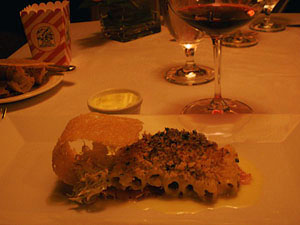 Cook pasta in 4 quarts boiling salted water until roughly half done. (See my comment below). Drain and place in a small bowl. Add a drizzle of olive oil and toss to keep from sticking. Set aside to cool. In a large saucepan over medium low heat melt the butter. Add garlic and shallot and sweat for 5 minutes (not you, the garlic and shallot). Do not brown (nothing worse than burned garlic). Add the cream, bring to a boil, and simmer on reduced heat until cream has reduced by 1/4 and coats the back of a spoon.
Cook pasta in 4 quarts boiling salted water until roughly half done. (See my comment below). Drain and place in a small bowl. Add a drizzle of olive oil and toss to keep from sticking. Set aside to cool. In a large saucepan over medium low heat melt the butter. Add garlic and shallot and sweat for 5 minutes (not you, the garlic and shallot). Do not brown (nothing worse than burned garlic). Add the cream, bring to a boil, and simmer on reduced heat until cream has reduced by 1/4 and coats the back of a spoon.
Whisk in the grated cheeses and stir for a minute or so until all is melted and smooth. Season with the nutmeg, salt and pepper. Chef O’Connell suggests the optional step of passing the sauce through a strainer. This is not necessary. Any particles of fully minced garlic and shallot will be undetectable once mixed with the pasta. Add the partially cooked pasta and simmer all ingredients “for a minute or two to make sure the pasta is warmed through.”
The words in quotes are verbatim from the cookbook and give me some concern. Note that Chef O’Connell recommends cooking the pasta until about half done. Warming it up later on for a “minute or two” in the white sauce will not complete the cooking as sure as I’m sitting here in front of my laptop! So best to cook the pasta until at least “al dente” and save yourself a potential embarrassment.
Place a parmesan wafer basket on each of four dinner plates and top with 1/2 cup of the pasta. Ladle a portion of the sauce on each and top with the julienned Virginia ham, chives and crispy onions. Finish with shaved slices of white truffle. (Honestly I would skip the onions and opt for toasted bread crumbs. The fried onions are a bit of a stretch for most people. It is unnecessary if the only purpose is to add a sort “gratin” crunch to the dish. In any case the onion flavor is a little tough to detect since the slices are so thin).
All right, and now. . . . .
Chef Ludovico’s Mac ‘n Cheese “alla Gricia”
For 4 persons
-
1/2 lb. or more cut pasta such as ziti or rigatoni
-
2-3 tbsp. olive oil
-
2 tbsp. butter
-
1/2 tbsp. minced garlic
-
1 tbsp. minced shallot (can substitute onion, no problem)
- 2 cups heavy cream
- 1/2 cup freshly grated imported pecorino romano cheese
- 1/2 cup freshly grated imported parmesan
- pinch of freshly grated nutmeg
- 1/2 cup or more thinly sliced short strips of pancetta, guanciale or prosciutto (thick-sliced “country” ham or bacon will do also)
- salt and cracked black pepper (take 1 tbsp. peppercorns and work them over in a mortar and pestle)
- 1/4 cup truffle oil
- optional 2 or 3 oz. sliced white truffles (which you obtain by taking a fast side trip to Turin in Northern Italy)
- 1/2 cup plain breadcrumbs lightly toasted in 1 tbsp. garlic-infused olive oil (optional, but the crunch is a nice touch and provides a convenient link to traditional American mac n’ cheese)
- 7-inch rounds of parmesan cheese crisps formed in basket or bowl shape
Cook pasta in 4 qts. boiling salted water until “al dente.” Drain and place in a bowl with a drizzle of olive oil to prevent sticking. Allow to cool. Meanwhile saute’ pancetta or guanciale in a large saucepan until most fat is rendered. Remove from pan and drain off fat, leaving a little coating in the pan for flavor. Add butter and 1 tbsp. olive oil and at low heat saute’ garlic and shallot until softened and translucent. Return pancetta or guanciale to the pan and add the cream, bring to boil, then reduce heat and allow cream to reduce by 1/4. Whisk in the grated cheeses and stir until melted. Add the cooked pasta salt, pepper and nutmeg and warm thoroughly.
Serve pasta on baked parmesan baskets or bowls. Top with a sprinkling of the garlic-flavored bread crumbs and sliced white truffles (hope you had a good trip). Otherwise drizzle with truffle oil.
For the parmesan crisps: Preheat oven to 300 degrees. Have four cereal bowls standing by upside down. Start with 6 oz. or more grated imported parmesan cheese. Line a baking sheet with oven paper lighly oiled on top. Divide the cheese into five mounds, around 2 heaping tbsp. each one, and place on the sheet (five because one of them is bound to break apart when being molded into a basket or bowl shape). Spread each mound around to form a thin flat circle making sure there are no spaces within the circle. Each disk should be about 7 inches in diameter with at least 2 inches of space between each. Bake for 5 minutes or so until disks just barely beginning to turn brown. If they brown start over because burned parmesan tastes like stale tobacco.
Remove from oven and place the warmed disks on top of the cereal bowls. Allow the edges to fall so that a basket shape is obtained but make sure the top surface is flat against the bottom of the bowl so the basket will stay in place on the plate. Once hardened carefully remove from the bowls and lay the baskets onto the serving dishes. If they set up properly and don’t break apart you can apply for an honorary certificate of achievement from the Cooking School at the University of Parma, Italy, the home town of Parmigiano Reggiano.
For the crispy fried onions: Using a mandolin thinly slice 1 Spanish onion into rings. Dredge in flour, shake off excess and deep-fry in 350 degree oil for about 30 seconds. Drain on paper towels. At my dinner at the Inn the onions were crumbled and sprinkled atop the pasta. In the cookbook photo they lie whole in ring form on the plate. Now if you can make a batch of paper thin onion rings without having them stick to one another in a tangled mass you should apply for an honorary certificate of achievement from the Cooking School of the University of Seville, Spain, home town of the Spanish onion.
If all this sounds like too much you can always reach for the the Kraft mac n’ cheese, drizzled with a tablespoon or two of truffle oil, which by the way costs about five times as much as the mac n’ cheese box.
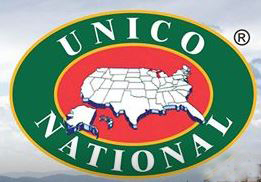 I’m talking about a pasta recipe contest sponsored by the Delaware chapter of a national Italian-American service organization called UNICO. And you would be correct, members are called “unicans”.
I’m talking about a pasta recipe contest sponsored by the Delaware chapter of a national Italian-American service organization called UNICO. And you would be correct, members are called “unicans”.
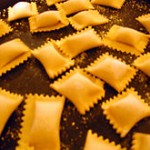
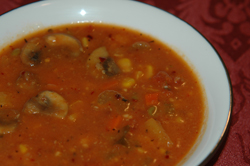 Inevitably we come around to the No. 1 staple dish for all Italians and Italian-Americans, not to mention a few million Brazilians and Argentinians whose Italian ancestors boarded boats for the U.S. that ran off course.
Inevitably we come around to the No. 1 staple dish for all Italians and Italian-Americans, not to mention a few million Brazilians and Argentinians whose Italian ancestors boarded boats for the U.S. that ran off course. If you have the misfortune of finding yourself on Washington’s Capital Beltway, alias Hell’s Freeway, where snails can get to your destination well ahead of you, there is an exit that will take you westward to a land virtually unspoiled by urban civilization, noise and pollution. It lies at the foothills of the Blue Ridge Mountains. Taking the Interstate 66 exit you will glide past the clutter and cacophony of Washington’s overbuilt Virginia suburbs and enter a region loaded with history, natural beauty and people in no hurry at all.
If you have the misfortune of finding yourself on Washington’s Capital Beltway, alias Hell’s Freeway, where snails can get to your destination well ahead of you, there is an exit that will take you westward to a land virtually unspoiled by urban civilization, noise and pollution. It lies at the foothills of the Blue Ridge Mountains. Taking the Interstate 66 exit you will glide past the clutter and cacophony of Washington’s overbuilt Virginia suburbs and enter a region loaded with history, natural beauty and people in no hurry at all.
 Chef O’Connell is a person who can probably duplicate any classical dish from any ethnic or regional cuisine in the world with his eyes closed. However his masterpieces are not strictly classic. They are original creations in every sense yet they have features easily and gratefully recognizable by classical one-track-minded amateur cooks like me.
Chef O’Connell is a person who can probably duplicate any classical dish from any ethnic or regional cuisine in the world with his eyes closed. However his masterpieces are not strictly classic. They are original creations in every sense yet they have features easily and gratefully recognizable by classical one-track-minded amateur cooks like me. Cook pasta in 4 quarts boiling salted water until roughly half done. (See my comment below). Drain and place in a small bowl. Add a drizzle of olive oil and toss to keep from sticking. Set aside to cool. In a large saucepan over medium low heat melt the butter. Add garlic and shallot and sweat for 5 minutes (not you, the garlic and shallot). Do not brown (nothing worse than burned garlic). Add the cream, bring to a boil, and simmer on reduced heat until cream has reduced by 1/4 and coats the back of a spoon.
Cook pasta in 4 quarts boiling salted water until roughly half done. (See my comment below). Drain and place in a small bowl. Add a drizzle of olive oil and toss to keep from sticking. Set aside to cool. In a large saucepan over medium low heat melt the butter. Add garlic and shallot and sweat for 5 minutes (not you, the garlic and shallot). Do not brown (nothing worse than burned garlic). Add the cream, bring to a boil, and simmer on reduced heat until cream has reduced by 1/4 and coats the back of a spoon.